 Leading Blog | Posts by Category |
 Leading Blog | Posts by Category |
01.22.15

A Beautiful Constraint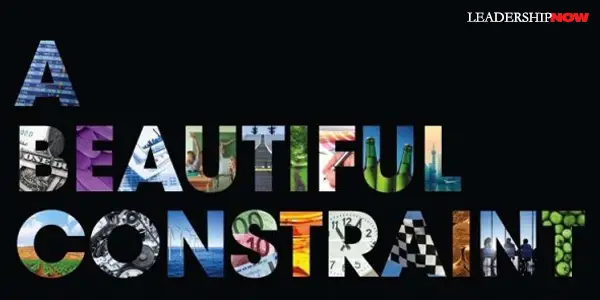
TYPICALLY we look at a constraint as a negative. A problem to be solved. But what if a constraint was the gift that opened up previously unimagined possibilities? What if a constraint was the gift that took you to the next level? Authors Adam Morgan and Mark Barden remind us in A Beautiful Constraint that Google’s home page is as simple as it is because that was the limit of Larry Page’s coding ability at the time. The overall-wearing hero Mario is as colorful as he is because of the challenges of eight-bit technology. And which of us would be using Twitter at all today if it had a limit of 14,000 characters rather than 140? We are all faced with the challenge of growing within the constraints of time, resources, method and /or people. Sometimes constraints are imposed on us and sometimes we benefit by placing constraints on ourselves. “We are living in an era of extraordinary people rewriting our sense of what is possible. They make an unarguable case that a constraint should be regarded as a stimulus for positive change—we can choose to use it as an impetus to explore something new and arrive at a breakthrough. Not in spite of the constraint, but because of it.” Organizations of all types—business, churches and schools—and people from all walks of life would benefit from understanding how to reframe a constraint into a better way of doing something. We begin the process by creating the right mindset. We need to increase our ambition relative to the constraint not to scale back our ambition to satisfy the constraint. That’s victim mentality. And that’s usually where we begin. Better yet, we can try to find a way to neutralize the constraint so we can deliver on our ambition. But the authors have created a path for us to become transformers—to find a way to use a constraint as an opportunity, possibly even increasing our ambition along the way. 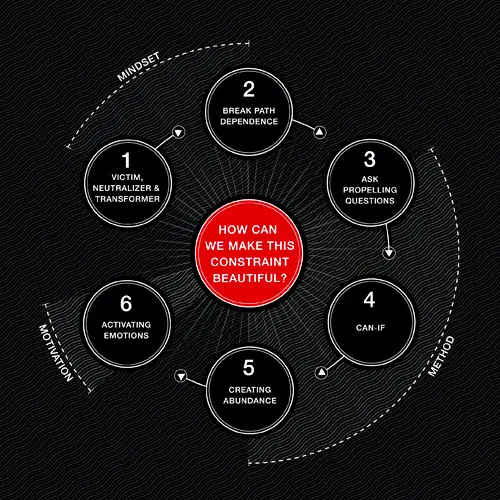 Often transformers will impose constraints upon themselves to force themselves to unearth different, possibly transformative strategies and solutions. This helps to reduce path dependence or the assumptions and ways of thinking about solutions that define “the way we do things around here.” “Today’s path is really yesterday’s path.” We must examine all of the ingrained habits that may stand in the way of our being able to see and realize the possibilities in a constraint. To bind our bold ambition to a significant constraint we have to ask a propelling question. The kind of “what if…?” question that forces us to think and behave in a better way. “If we don’t ask propelling questions of ourselves, someone is going to ask them of us, and by that time we will be behind the curve.” To answer a propelling question we need to answer not with a “we can’t because” statement but with a “we can if” statement. It focuses the nature of the conversation on how something could be possible and not on whether it would be possible. Then we get resourceful. What stops us from being more resourceful is the way we think about resources. We tend to think of the resources available to us as the ones within our immediate control. But there are all kinds of resources outside of our immediate control. One method is to create shared agendas. “We, who might appear to have little, need to help them see that we have what they want.” There are organizations that routinely embrace constraints to make themselves better. The beautiful constraint process cannot be managed, it must be led. “When making constraints beautiful, motivation is method. Breakthrough happens when a propelling question meets strong emotions. Without activating the right emotions, it will be too easy to regress to the victim mindset.” The authors note that “if we are heading into a more constrained future, then how we manage those constraints will determine how we progress.” As a leader, steering your organization towards constraints sooner rather than later, is an important source of competitive advantage. Raising the level of ambition alongside a constraint encourages growth and learning—both individually and organizationally—because it causes us to reexamine our current paths, assumptions, and ways of thinking. A Beautiful Constraint is a outstanding book with inspiring examples that will spark your imagination to create your own beautiful constraint. It should be standard issue to every student as the thinking described here will serve them well in life. What constraint will you go and make beautiful? 
Posted by Michael McKinney at 10:02 PM
11.26.14

Learn or Die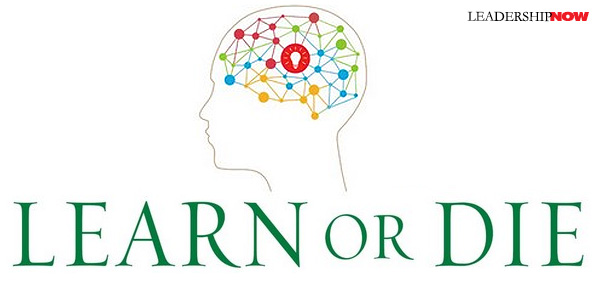
OUR ABILITY (and willingness) to learn impacts our personal and business growth, operational excellence, and our capacity to innovate. More than ever, it truly is learn or die. In Learn or Die, Ed Hess writes that learning is impacted by our “reflexive ways of thinking, the rigidity of our mental models, and the strength of our ego defense systems.” So to a large degree is means overcoming our humanness. We prefer to validate what we already know rather than looking at evidence to the contrary. By and large, that’s a function of our ego. “In many cases, learning comes from mistakes or failures or other people disagreeing with us, which that means in order to learn, we often have to admit that we are wrong.” The author admits that “To become a better learner, I had to quiet my ego.” As a result, he also became a better thinker and leader. Negative thinking is toxic to learning. “In order to maximize our learning we have to be sensitive to and manage our emotions.” As a leader, you need to be concerned about the environment of the people you lead. “The litmus test of a learning organization is being receptive to information that goes against the established way and a tolerance for failure and mistakes.” To accomplish this not only should the environment be positive, but people need to be treated with respect, dignity, and trust, mistakes should not be characterized as “personal failures but as the result of bad learning systems or too little effort,” people should also believe that they have some control over their actions, have a sense of self-efficacy and contribution. Hess writes that “The U.S. Army Special Forces believes that adaptability—learning—is predicated on self-efficacy, resiliency, open-mindedness, mastery achievement motivation, and tolerance for ambiguity and uncertainty.” Too often we sabotage our own learning by our need to be right. We need to be able to admit when we are wrong and quite frankly accept the “magnitude of our ignorance.” “Real learning, in most cases, requires us to change what we believe, and humble inquiry [open-mindedness with no predetermined or hidden agenda], helps us do that.” Because we have difficulty seeing ourselves and examining our own assumptions, “learning is a team sport.” If we want to learn, we “must engage in effective learning conversations.” Learning conversations are conversations where we feel safe in disclosing ourselves to others. They bring about a deliberate, nonjudgmental, non-defensive open-minded exchange. We learn from each other.
The culture at Bridgewater may seem extreme to some but there is no doubt that they are serious about growth and learning. As Ray sees it, achieving one’s goals is more likely to occur if one strives to be an independent thinker by learning. That, in turn, requires one to be honest about one’s strengths and weaknesses and to deal directly with one’s weaknesses by accepting them, seeking and being open to feedback and creating workarounds that mitigate one’s weaknesses. At Bridgewater, everyone knows everyone else’s strengths and weaknesses. It’s part of their company-wide feedback loop. It’s based on truth which Ray believes “is the essential foundation for producing good outcomes.” “Searching for the truth and confronting one’s personal weaknesses in a radically transparent environment builds personal relationships.” At Bridgewater they are just as concerned about how one arrives at an answer as they do the answer itself. They encourage people to be independent thinkers. A former Navy SEAL came to work at Bridgewater because he said the two cultures overlapped. “He said both organizations focus on learning, adaptation, recruiting high caliber people, and teaching them to be better thinkers and to relentlessly pursue constant improvement.” Bridgewater has created a series of tools for use in evaluating employees and for employees to manage their personal growth” the Dot Collector and Dot Connector, Issues Log and Issue Log Diagnosis Card, Pain Button and Baseball Card. With the Dot Collector allows anyone to give any other employee performance feedback. The Dot Connector is a database of feedback every employee has received from anyone. The data is grouped according to a list of seventy-seven attributes and then summarized to give each employee a picture of his or her feedback by strengths and weaknesses and by attributes. The Pain Button app is based on Ray’s formula: Pain + Reflection = Progress. “The purpose of the pain app is for one to write down and reflect on the ‘pains’ one is experiencing in order to understand what’s causing them and to deal with those causes effectively.” Ray himself is included in the process and is subject to evaluation by anyone in the company. Frankly, I have never read about an organization with such radical transparency. Hess says that in all of his research of over 100 high-performance companies over the past ten years, Bridgewater is the only business organization he has found that “has squarely faced our ‘humanness.’” Learn or Die is a book everyone who is serious about learning and growth—personally or organizationally—should read. If you thought you were serious about it, Learn or Die will take you to a whole new level with tools, case studies, and insights that will challenge your commitment to learning.

Posted by Michael McKinney at 11:28 AM
08.06.14

How to Accelerate Learning and Change Lives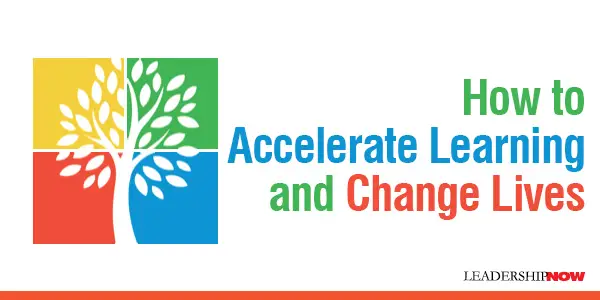
TEACHERS are the builders of the future. In a book written for teachers, we find a valuable book for all leaders because leaders are teachers. Leaders are educators. In The Best Teacher in You, you will find the thinking and approaches behind highly effective teachers who accelerate learning and change lives. There are two kinds of change that individuals experience: incremental change and deep change. “We frequently make incremental changes: We make adjustments, we elaborate on a practice, we try harder, and we exert a greater degree of control. In other words, we attempt to solve the problem using the assumptions we currently hold. Deep change is more demanding because it requires the surrender of control….It involves embracing purpose and then moving forward by trial and error while attending to real-time feedback.” It is deep change that we seek to bring about as teachers and leaders. There are two views to making this happen: directive and co-creative. A directive perspective suggests the teacher directs and controls the classroom. “Teaching is a process in which a more expert person imparts knowledge or skill to a less expert person.” A directive perspective is a place to begin but when we build on it, we grow into a co-creative perspective and we move beyond direction, control, discipline, and repetition. “As the teacher and the students commit to a common purpose and form high-quality relationships, they become a system that has emergent possibilities. In a co-creative, collaborative environment, students hold each other accountable, leadership is shared, and new perspectives emerge. The teacher/leader becomes a facilitator. In a practical way, the authors—Robert Quinn, Katherine Heynoski, Mike Thomas, and Gretchen Spreitzer—have developed a framework consisting of four themes at the center of highly effective teachers' practice. It incorporates both the directive and co-creative perspectives. Each area of effectiveness is associated with particular skills and preferences and all the quadrants have value. After we identify in which of these areas we can find our individual strengths, we can then accelerate our development when we begin to stretch from a position of strength toward an area of growth. If we are very “red” for example, our effectiveness might improve if we became more “yellow” or “green.” A very helpful concept.
Here are a few ideas presented in the book from highly effective teachers: Developing the desire to learn: “This process does not begin with her acting on the students. It begins with her acting upon herself. She does the internal work necessary to display her own enjoyment of learning…. [Finally the teacher] is no longer the center of attention, and neither are the students. At the center of attention is the process of learning. The class transforms from a hierarchy to an adaptive learning organization.” Structure: “Structure is not his purpose. Structure serves his purpose.” “Structure and control are paths to freedom and learning.” “Structure and routine are there so students can work outside the box.” “I think the more structured and organized I am, the more creative we can be. Without structure it doesn’t work. We need organized chaos. We need some way to manage the mess. Structure and order free me.” Enhancing relationships: Sarah’s “most immediate concern is how to negotiate the rift between the content she must teach and the real-life experiences of her students.” Students are often “passive observers of their education because the directive perspective is taken too far. She feels that overly directive teaching can minimize the emotional content of the curriculum. Rather than tell her students what is right or wrong, she wants them to engage and ‘negotiate’ difficult social issues so that they come to their own deep understanding of what is right and wrong.”

Posted by Michael McKinney at 09:08 AM
07.25.12

If It's Important, Be There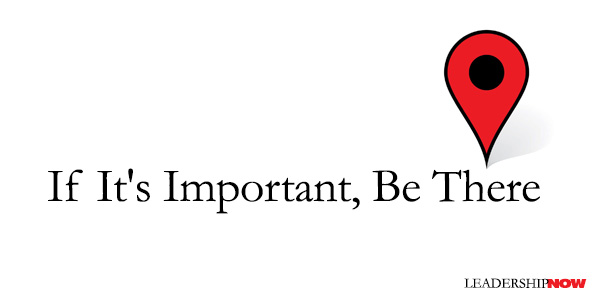
IN Contented Cows Still Give Better Milk, authors Bill Catlette and Richard Hadden make the point that organizations with contented employees understand that one of the most fundamental precepts in the whole workplace arena is that “the person who started for them this morning is as close to a ‘model employee’ as they’re ever going to get.” So the best companies do something about it. They are fanatical about training people not only with skills they need, but they also carefully train them in the organization’s traditions, values, and philosophies. But this is the part (too) many leaders just don’t get: “People want to know that the training course they’re taking the time to sit through is as important to senior management as it is supposed to be to them.” How do you communicate that? “This often requires senior management to ride along with them—not in their own condensed mini-versions, but alongside everyone else.” Catlette and Hadden go on to say, “There should be no executive parking spaces when it comes to training. Managers must participate enthusiastically and, more important, be able to demonstrate the skills they expect everyone else to learn.” The message is clear. If it’s important to you, it will be important to them. It’s quite common to hear, “If this is so important, where are they?” Without the visible support of the leadership, commitment to the training is compromised. Leaders need to visibly communicate: “This is important—so important that I went through it before you did. I’m using it, and now I want and expect you to do the same. That’s why I’m here." 
Posted by Michael McKinney at 11:49 PM
04.22.11

5 Leadership Lessons: What You Need to Know about Developing Teen Leadership
DAN APPLEMAN has written a handbook for developing teen leadership. Based on over 20 years of real world experience, you will find ideas, techniques, examples and even sample statements to guide you. Developing Teen Leadership will not only help you develop leadership skills in yourself and others, but you will find ways to help teens help other teens on their leadership journey. The challenge for most parents, teachers and teen advisors is first understanding what they believe about leadership. If we think leadership is telling people what to do, it is difficult to guide their understanding of what real leadership is. They learn best by example. Appleman offers over 50 valuable thoughts that impact your effectiveness with teens. Here are just five:
This is not a book about teens. It is a book about how we as adults relate to teens. Because the only tool we have to teach leadership skills (or anything) to teens is the control we have over our own actions. You can spend hours worrying about what the teens are doing or their attitude, but we can only control the things we do and our own attitude. 
Posted by Michael McKinney at 07:10 PM
03.10.11

A Case for Reconsidering the Way We’ve Always Done It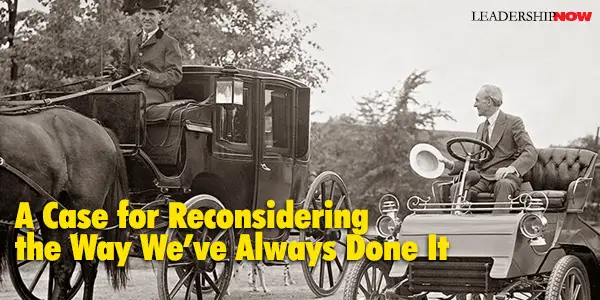
S SOCIETY that doesn’t train their children to think critically, to be aware of those around them, and to serve, must create more rules and regulations than can be accounted for. There will never be enough rules—there are too many variables—especially when people begin to direct their creativity in dysfunctional ways. The challenge is to develop sound minds. As Kant determined, a person with a sound mind is one that can think for oneself, is able to place oneself in the place and viewpoint of others, and can think consistently and coherently. But it‘s easier, in the short term, to create rules. And we pay a price. To be sure, I am not advocating anarchy—we absolutely must have rules—and some rules unquestionably make possible the learning process, but when the rules we have in place reflect our lack of engagement, they become disrespectful and de-motivating. It’s easier to lay down the law or set up a checklist than it is to explain the why; to communicate where we’re headed with this idea. From time to time, it is good to think about the rules we have created (or have had handed down to us), that are impeding progress, relevance, imagination, and growth both for ourselves and others. Here are a few thoughts to guide that process: I am a big advocate of tradition, but when “that’s the way we’ve always done it” or “that’s how I learned to do it” gets in the way of relevance or growth, we need to take a step back and reconsider our stand. What we have done may have served us well in a particular place and time, but may only be an irritation here and now. Rules can reveal a lack of trust. “I don’t trust you to be as smart—considerate or creative—as I am.” And they never will be if not given the chance. As leaders, we need to be aware of where we are blanketing people with rules and procedures that do nothing more than to serve us and not the people it is our intention to serve. We need to consider that perhaps we have implemented rules to create a comfort zone for ourselves. A world where people act and think like we do. A world of clones. A world on autopilot that requires less of us. Often our need for rules and procedures is just masking our fear of the unknown. Our attempt to manage a world that is changing faster than we are learning. No leader can do it on their own and rules are no substitute for not trusting, growing and building relationships with people. Where are we hiding behind rules? Rules, for the most part, do not leverage other people’s strengths and thinking, they mostly mirror our own. Given the chance, people will surprise us with new, different, and better ways to push our agenda forward.
Posted by Michael McKinney at 11:43 AM
12.17.09

Teaching, Like Leadership, is a Labor of Love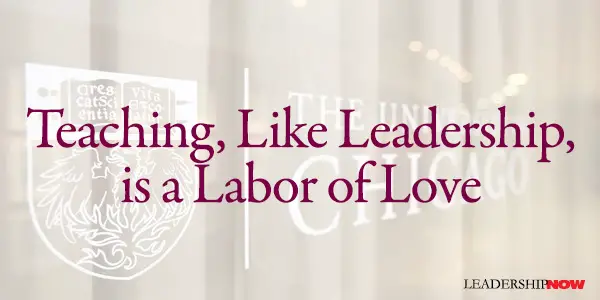
MUCH of what we do everyday involves some kind of teaching—conveying information to others. We can be enlightened by the discussions from the educational arena on what it means to teach and how people learn. Teaching done right is really a labor of love. It’s having a mind oriented toward the future; seeing a bigger picture beyond what is actually being taught in the present.  Magill says that the faculty at the Laboratory Schools are carefully chosen not just for their expertise but “because of their character and because they believe that education can make a difference in how human beings treat each other.” This summer I read a very interesting article with the title “Higher Education Is Stuck In the Middle Ages–Will Universities Adapt or Die Off in Our Digital World?” Its premise is that universities are losing their monopoly on higher learning to the world-wide-web, as the Internet has suddenly become the global platform for the exchange of knowledge between people. Listen to this quote: The old-style lecture, with the professor standing at the podium in front of a large group of students, is still a fixture of university life on many campuses. It’s a model that is teacher-focused, one-way, one-size-fits-all, and the student is isolated in the learning process. Yet the students, who have grown up in an interactive digital world, learn differently. Schooled on Google and Wikipedia, they want to inquire, not rely on the professor for a detailed roadmap. They want an animated conversation, not a lecture. They want an interactive education, not a broadcast one that might have been perfectly fine for the Industrial Age or even for boomers. These students are making new demands of universities, and if the universities try to ignore them, they will do so at their peril. Just as some Universities may be at peril, I know that pre-collegiate education is in trouble at many schools, both public and private. With discovery, creativity, and well-roundedness being pushed to the background while measuring success through federal and state testing programs remains politically popular, it is not surprising that both home instruction and on-line programs keep growing at exponential rates. The structure of a Laboratory Schools’ education, from nursery through high school, demands thinking and learning for all, as opposed to it being an option for only the self-motivated. Do + Think = Learn was from the beginning, is today, and must in the future be our main thing. This coming Saturday, our youngest daughter is getting married in Denver, Colorado. …During the time that I was preparing these remarks, I was also thinking ahead to her wedding and what advice I might give her. … Ironically, I found some parallels with the institution of marriage and this wonderful profession that we chose and would like to practice what I intend to say to her by sharing a few nuggets of wisdom with you. 1. Marriage is not just between two people. Inheriting your spouse’s family is part of the deal. Likewise, working with someone else’s children is not an isolated act. It is done under scrutiny, loving and otherwise, and as a member of a much larger community. 2. Marriage partners need to know, show, and grow their core values. Likewise, we need to remind ourselves why we chose this profession, be able to express what is at the core of our school’s experience, and reject complacency as we become more experienced. It is those core values, not your new home nor our buildings that, in the end, will matter the most. 3. Marriages that last and stay happy are those in which the partners keep falling in love at least once a year. Likewise, our best work occurs when we keep immersing ourselves and falling in love with what we do. So, on this first day of the 2009-2010 school year, renew your vows, and may you once again fall in love.
Posted by Michael McKinney at 09:43 AM
03.23.09

MBA Arrogance and the Myth of Leadership
PHILIP Delves Broughton, author of Ahead of The Curve: Two Years at Harvard Business School, writes in the Financial Times about MBA Arrogance and the Myth of Leadership. Broughton observes: What business schools can teach is organisational behaviour. They can teach compensation systems and recruitment processes. They can offer classes on cash and non-cash incentives, on training, promotion and the value of a corporate culture. They can offer frameworks for negotiations, strategy decisions and implementing change. But when they bundle this up and call it leadership, they risk leaving their students with the faulty impression that they are now qualified, if not obliged, to go into the world and lead. It breeds the arrogance for which MBAs are mocked. It is the merit of Broughton to remind readers of the problems of surrounding leadership education. He is right. Business schools are best at teaching the competencies that business leaders need when performing their tasks. And at this point in time, they are probably rethinking what that means. Teaching leadership – as in take these classes and read these books and you are a leader – is something else. Broughton correctly asserts that MBA students often walk out into the world thinking that they are uniquely equipped to lead the world. It’s an arrogance that is rarely appreciated in the real world and an approach that does not serve them well in the long-term. Books and lectures do not make you a leader, but they can give you the tools to become a leader through the practice of leadership. They point you in the right direction. They fast-track your awareness. They are extremely valuable but they do not make you a leader. That label is earned, not taught. Broughton states, “Not all MBAs can be leaders, nor need they be. Every business needs followers: people who are good at what they do, who are able to implement the plans laid out by leaders.” Here is where discussions of leadership often derail. Broughton is confusing leadership with position. Position is the brass ring and there are a limited number of those to go around. Most people will be left out. He’s right. We can’t all have position, but we can all be leaders. Likewise, we are all – regardless of our position – followers. The idea that “I’m a leader, not a follower” is a foolish notion and belies the ignorance of what leadership really is by anyone who states it. Leadership is intentional influence. Basic to a proper understanding of leadership is the understanding that leadership is not position and does not make you a leader. There was a time when management was just management, the science of providing organizational support for innovators and salespeople to win customers and revenue. No, business schools need leadership courses. They just need better ones. They need courses with a proper emphasis about leadership. I appreciate his phrasing – “this super-sizing of management” – but management and leadership go together. They are often separated so that we can, by pulling them apart, see how they fit together. We need both and we need to be practicing both. One is not better than the other. A good leader manages. A good manager leads. 
Posted by Michael McKinney at 10:50 AM
12.04.08

What is the Secret of Great Performers?
MALCOLM GLADWELL tells us in Outliers that when it comes to success, context is everything. Only by asking where a person comes from can we understand who succeeds and who doesn’t. Geoff Colvin would agree but there’s more. In Talent is Overrated, Colvin rightly asserts that “great performance is in our hands far more than most of us ever suspected.” When many people never become outstandingly good at what they do, no matter how many years they spend doing it, why do some people become excellent at what they do? Colvin convincingly argues that in general, it’s not innate gifts or intelligence, but what researchers call deliberate practice that creates world-class performers. A study by Anders Ericsson and his associates concluded that “the differences between expert performers and normal adults reflect a life-long period of deliberate effort to improve performance in a specific domain.” Deliberate practice is not your normal practice. It contains several important elements: it’s designed specifically to improve performance (usually with a teacher or coach), it can be repeated ad nauseam, feedback on results are continuously available, it’s highly demanding mentally (focus and concentration), and it isn’t much fun. Add passion and the good news is that great performance is not reserved for a preordained few. It is available to everyone. Colvin’s homework makes a great case for the idea that leaders are developed. What is alarming is Colvin's observation that “At most companies—as well as most educational institutions and many nonprofit organizations—the fundamentals of great performance are mainly unrecognized or ignored.” He writes that organizations that apply the principles of great performance follow several major rules:
Talent is Overrated is the most readable and pragmatic book on the topic. The examples and relevant research cited are compelling and his application of great performance principles to self-development, business development, and innovation are thought-provoking. Related Interest:

Posted by Michael McKinney at 02:29 AM
11.14.08

Hiring the Right Skill Set and Motivating the Millennials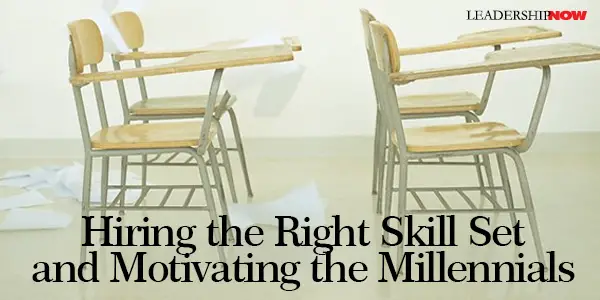
IN RAISING and schooling our children in the U.S., it appears we have dropped our standards. And it shows. Finding the right people is becoming a more and more difficult proposition. (I enjoyed reading about Linda Zdanowicz's search for a dental assistant on her blog.) Tony Wagner, author of the The Global Achievement Gap has written an important book that should not be ignored by business leaders. It sets a meaningful agenda for a good dialogue between educators and business leaders and concerned parents about our educational system. Wagner has written the following for us: In an economic downturn, employers need to be even more careful with their hiring decisions. And recent graduates from some of the best schools may not have the skills that matter most in the new global knowledge economy. In researching my book, The Global Achievement Gap: Why Even Our Best Schools Don’t Teach The New Survival Skills Our Children Need -- and What We Can Do About It, I have come to understand that there are "7 Survival Skills" for the New World of Work, and that employers must look beyond applicants' "pedigrees" to carefully assess whether they have the skills that matter most. New Skills Here are the Seven Survival Skills, as described by some of the people whom I interviewed: • Critical Thinking and Problem Solving "The idea that a company's senior leaders have all the answers and can solve problems by themselves has gone completely by the wayside . . . The person who's close to the work has to have strong analytic skills. You have to be rigorous: test your assumptions, don't take things at face value, don't go in with preconceived ideas that you're trying to prove." —Ellen Kumata, consultant to Fortune 200 companies
• Collaboration Across Networks and Leading by Influence "The biggest problem we have in the company as a whole is finding people capable of exerting leadership across the board . . . Our mantra is that you lead by influence, rather than authority." —Mark Chandler, Senior Vice President and General Counsel at Cisco
• Agility and Adaptability "I've been here four years, and we've done fundamental reorganization every year because of changes in the business . . . I can guarantee the job I hire someone to do will change or may not exist in the future, so this is why adaptability and learning skills are more important than technical skills." —Clay Parker, President of Chemical Management Division of BOC Edwards
• Initiative and Entrepreneurship "For our production and crafts staff, the hourly workers, we need self-directed people . . . who can find creative solutions to some very tough, challenging problems." —Mark Maddox, Human Resources Manager at Unilever Foods North America
• Effective Oral and Written Communication "The biggest skill people are missing is the ability to communicate: both written and oral presentations. It's a huge problem for us." —Annmarie Neal, Vice President for Talent Management at Cisco Systems
• Accessing and Analyzing Information "There is so much information available that it is almost too much, and if people aren't prepared to process the information effectively, it almost freezes them in their steps." —Mike Summers, Vice President for Global Talent Management at Dell
• Curiosity and Imagination "Our old idea is that work is defined by employers and that employees have to do whatever the employer wants . . . but actually, you would like him to come up with an interpretation that you like -- he's adding something personal -- a creative element." —Michael Jung, Senior Consultant at McKinsey and Company
Looking Beyond the Degree The conventional thinking of many who make hiring decisions is that graduates from "name-brand" colleges are likely to be more intelligent and better prepared than students who have gone to second or third tier schools. But, in reality, what the degree may mean is that these students are better at taking tests and figuring out what the professor wants -- skills that won't get them very far in the workplace today. A senior associate from a major consulting firm told me that recent hires from Ivy League business schools were constantly asking what the right answer was -- in order words, how to get an "A" for the job they were doing -- and were not always very adept at asking the right questions, which was the single most important skill senior executives whom I interviewed identified. So what does this mean for the interview process? First, listen carefully for the kinds of questions the applicant asks. Are they probing? Insightful? Do they suggest that the applicant has really prepared for the interview by trying to understand your business? Do you feel as though you or your company are being interviewed? If so, that's a very good sign. How a prospective employee asks these questions matters, as well. Does he or she listen carefully and engage you in discussions? Is the potential new hire both interested and interesting? In addition to the ability to ask good questions, senior execs told me that the ability to "look someone in the eye and engage in a thoughtful discussion" is an essential competency for working with colleagues and understanding customers' needs. Finally, perhaps the most important question you might ask is, "what do you want to learn or how do you want to grow in this job?" This question is essential for two reasons: First, the quality of the answer will tell you how reflective this individual is -- and how intentional he or she may about his or her own development. More than any specific skill, individuals must want to learn, grow, and improve continuously to be successful in today's workplace. Motivating the Millennials The second reason why this question is important goes to the heart of the problem of how to motivate new hires to do their best. In asking the question, "how do you want to grow," you are signaling to a prospective employee that you and your company are committed to developing the talents of your workers. Many employers worry that this generation lacks a work ethic. But in my research, I have discovered that this generation is not unmotivated but rather differently motivated to learn and to work. Above all else, they want opportunities to be challenged and to make a difference. Describing the different work ethic of this generation, Ellen Kumata, who is a managing partner at Cambria Associates and consults to senior executives at Fortune 200 companies, told me, "They don't see coming into a company as being a career experience. They don't want to climb the corporate ladder and make more money and please the boss. And so you can't manage them the same way -- you can't just put them into a cubicle and expect them to perform." Tracy Mitrano, who manages the Office of Information Technologies at Cornell University, agreed: "You have to make the work more interesting and allow them to work in different ways. They are prepared to work just as much and just as hard -- but not at a desk 8 hours a day." Andrew Bruck was finishing a law degree at Stanford when I interviewed him last year. "We want to feel ownership. We have a craving for an opportunity to do something really important," he told me. "People in my generation have been in a constant state of training. Now they're excited to go do something. The more responsibility you give people, the better they produce . . . There are more and more recent law school grads who are willing to take a lower salary in return for an opportunity for more meaningful work." Ben McNeely, a journalist, described to me the difference between his former employer and his current one. "At the paper where I worked previously, the publisher would kill stories if they portrayed an advertiser in a negative light. At the paper where I work now, I have an opportunity to contribute something in a growing community. I was brought in to cover the new bio-tech research campus under construction nearby, where the Canon towel factory used to be, and to cover health care issues, as well. I have support from the editor and publisher who both have strong journalistic ethics. I like it that the editor pushes Windham, who us to dig deeper." Carie Windham, who graduated from college in 2005, told me about the best boss she's ever had. "He asked me where I want to be in 10 years. He talked to me about creating the experience I want to have. He understood I wouldn't be there forever . . . Mentoring is a huge motivational tool, someone showing an interest in you and giving you feedback. We want to feel we have a creative, individual role -- that we're not just working on an assembly line. We want to feel like we have ownership of an idea." Hiring the right talent, then, is only part of the problem employers face today. Equally important is how businesses create challenges and learning opportunities that motivate the Millennials to do their best. Google, which had more than one million applications for 5,000 jobs in 2006, is the number one pick of a place to work for many of the Millennials. Listening to twenty-two-year-old Matt Kulick talk about his work, one begins to understand how profoundly many companies will have to change in order to attract and retain the best talent: "First, they (Google) share ideals that I believe in—open source software. And their products are solving important problems for people—doing good in the world. I believe in what they're doing—these values are very important to me. I wanted to help out, to make a contribution. The second reason I came to Google is because they give me the resources I need to accomplish major things that will really make a difference in the world. The third reason is the responsibility they give you from the day you start. It is a winning combination. It makes me happy to go to work every day."   
Posted by Michael McKinney at 06:07 AM
11.07.08

Outliers: Understanding the Context of Success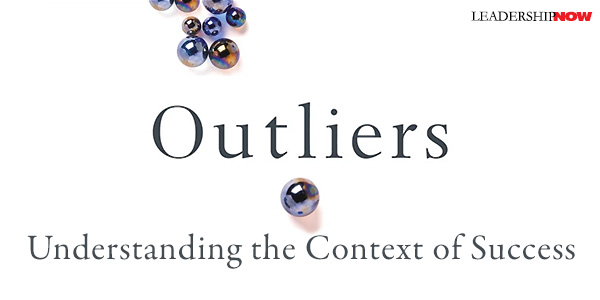
A LOT has been written of late about superior performance that often sets conventional thinking on its head. We often assume genius and success is the result of natural gifts and if you don’t have it, then you don’t have it. But research is demonstrating that great performance is more about what we do after we are born than we ever thought. People don’t rise from nothing. In his new book Outliers (men and women who do things out of the ordinary), Malcolm Gladwell writes:We pretend that success is exclusively a matter of individual merit. But there’s nothing in any of the histories we’ve looked at so far to suggest things are that simple. These are stories, instead, about people who were given a special opportunity to work really hard and seized it, and who happened to come of age at a time when that extraordinary effort was rewarded by the rest of society. Their success was not just of their own making. It was a product of the world in which they grew up.Gladwell provides countless stories and examples of successful people—Bill Joy, Bill Gates, the Beatles, Chris Langan and others—and draws interesting connections about their success. Successful people must be considered within the context of their culture and the people that surrounded them. “The values of the world we inhabit and the people we surround ourselves with have a profound effect on who we are.” The people who stand before kings may look like they did it all by themselves. But in fact they are invariably the beneficiaries of hidden advantages and extraordinary opportunities and cultural legacies that allow them to learn and work hard and make sense of the world in ways others cannot. If you look hard enough, there is a pattern of achievement. It’s a fascinating read. Related Interest:

Posted by Michael McKinney at 06:14 PM
10.17.07

The Teacher Can Only Be a Help or An Impediment To Learning
IN 1969, Peter Drucker published the leadership classic, The Age of Discontinuity: Guidelines to Our Changing Society. In a discussion on the crisis in education, he argues that we don’t need more money, we need better methodology. We need creativity to improve productivity in the classroom. Few teachers spend in their entire teaching careers as much time or thought on preparing their classes as in invested in the many months of writing, drawing, acting, filming, and editing one thirty-second commercial. [The commercial] is indeed the prototype of the ideal “program” with its three key elements: effective sequence of the material, validation through repetition, and self-motivation of the learner through pleasure. A level of teaching that was acceptable to older generations, who had no standards of comparison, dissatisfies the children of the television age, bores them, offends them. How well do your presentations, your training, meet these criteria? If we are boring people, they will stop learning. 
Posted by Michael McKinney at 09:10 AM
10.15.07

Teaching and Learning Are Not the Same Thing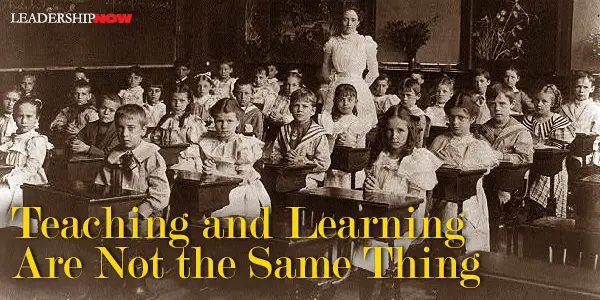
I don’t how often you have asked a teacher why they got into teaching, but all too often I hear, “Because I love kids.” Well, that’s a good reason to get into daycare, but hardly a good reason to get into teaching. It hardly surprising that our school boards think throwing money at the education problem will solve it. Teaching is a skill distinct from liking people or intellectual ability—although it’s good to possess both to be an effective teacher. Sadly, while teachers should be teaching (and many wish they were), too many find themselves babysitting. Make no mistake, this happens in the workplace too. Over 160 years ago, Horace Mann, American educator and founder of the first school for teacher education in the United States (1839), wrote, “The ability to acquire and the ability to impart are wholly different talents. The former may exist in the most liberal manner without the latter.” The ability to acquire is the power of understanding the subject manner of investigation. Aptness to teach involves the power of perceiving how far a scholar understands the subject matter to be learned, and what in the natural order, is the next step he is to take. It involves the power of discovering and of solving at the time the exact difficulty by which the learner is embarrassed. The removal of a slight impediment, the drawing aside of the thinnest veil which happens to divert his vision is worth more to him than volumes of lore on collateral subjects. In the workplace, as well, we would be wise to remember that teaching is an art that must be adapted to the students learning patterns and by those with an aptitude to teach. In both our schools and workplaces, we need to enable students to learn and teachers to teach. Next we will take a look at the thoughts that one of the most insightful thinkers of our time wrote on teaching, 128 years after Horace Mann.
Posted by Michael McKinney at 09:12 AM
09.21.06

Any College Will Do
IN Monday’s Wall Street Journal, Carol Hymowitz wrote an encouraging article entitled, Any College Will Do. She begins, "The college diplomas of the nation's top executives tell an intriguing story: Getting to the corner office has more to do with leadership talent and a drive for success than it does with having an undergraduate degree from a prestigious university.” Here are some highlights: Most CEOs of the biggest corporations didn't attend Ivy League or other highly selective colleges. They went to state universities, big and small, or to less-known private colleges. "I don't care where someone went to school, and that never caused me to hire anyone or buy a business," says Warren Buffett, CEO of Berkshire Hathaway, who graduated from the University of Nebraska-Lincoln. 
Posted by Michael McKinney at 01:20 AM
07.24.06

Growing Concerns: Preparing Children for the Future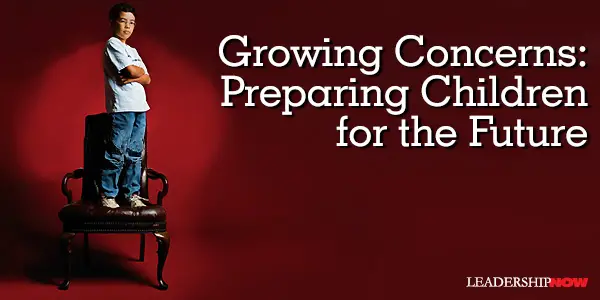
AT the 2005 National Education Summit on High Schools, Bill Gates remarked, “America’s high schools are obsolete. By obsolete, I don’t just mean that our high schools are broken, flawed, and under-funded – though a case could be made for every one of those points. By obsolete, I mean that our high schools – even when they’re working exactly as designed – cannot teach our kids what they need to know today. [W]e have to understand that today’s high schools are not the cause of the problem; they are the result.” In our conversations with a local school district, we suggested that the problems in the district are by and large brought on by the system itself. Unfortunately, they can’t get over the notion that the district's problems are the lack of money. True, due to the lack of money the Band-Aids are failing, but they are only a symptom. Unless the school board can drop this mindset, they will continue to face the same problems but with increasing intensity as time goes on. Obsolete paradigms keep otherwise bright people dumb because they can’t learn what needs to be done and develop a new approach. They have the answers but unfortunately, they can't see them.”  Michael Wald: I actually think childhood is getting longer. As more and more children go on to higher education, they are more dependent upon their families for longer periods of time. They live with their families well into their 20s. And most outcomes that we measure to gauge children’s well-being have improved in recent years.” William Damon: They’re creating their own families as much as a decade later than historical norms. And work commitments are being postponed beyond what any economy has ever tolerated in history. It creates a kind of moratorium where people can discover themselves and play out a lot of different possibilities, but the downside is that it creates uncertainty about what you’re going to end up doing in life. If you go back even a generation or two in our own society, when more kids were living on farms or helping their parents run delicatessens or whatever, they were taking responsibility early. I mean there were 14-year-old kids driving tractors all over this country and helping bring home the bacon. We’re not giving kids those kinds of responsibilities, even in disadvantaged families. Sometimes kids go out and get jobs at McDonald’s, but that’s different. They’re not running a little family business or preparing for a vocation, becoming a fisherman like Dad. A lot of kids are drifting, and are not so happy about it.” William Damon: What worries me is not the mass media; it’s the vanishing number of positive opportunities for constructive engagement that traditionally kids have had in our society. Everything from local playgrounds where parents used to let their kids go out and play stick ball to apprenticeships where kids would tag along with the neighborhood cop or show up at the newspaper and learn about reporting. If you get a kid involved in something positive, whether it’s sports or academics, or art, that kid is not going to get in trouble.” Fernando Mendoza: In my clinical experience, when you have parents engaged with kids, the kids can deal with a lot of negative influences. When parents, for whatever reason, don’t have the time or take the time to engage their kids, the chances are greater that media and other influences can sway kids.”
Posted by Michael McKinney at 10:13 AM
|
BUILD YOUR KNOWLEDGE


How to Do Your Start-Up Right STRAIGHT TALK FOR START-UPS 
Grow Your Leadership Skills NEW AND UPCOMING LEADERSHIP BOOKS 
Leadership Minute BITE-SIZE CONCEPTS YOU CAN CHEW ON 
Classic Leadership Books BOOKS TO READ BEFORE YOU LEAD |
|